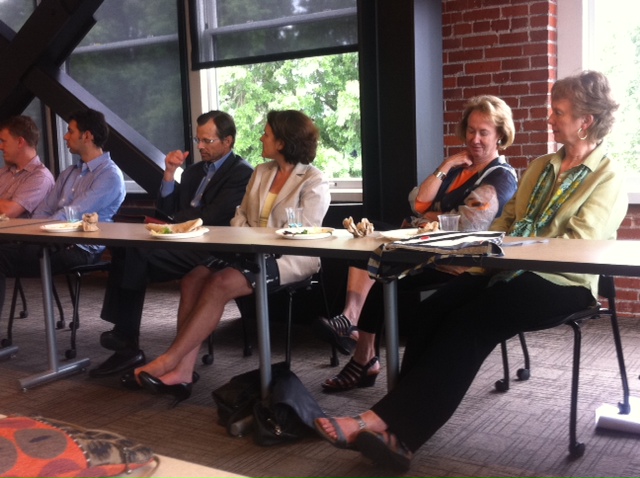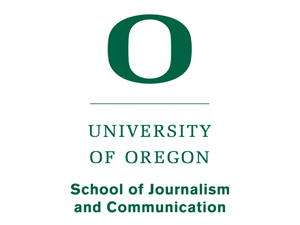Blog:
JA Market Scan: U of O’s School of Journalism and Communication prepares to launch a new Center for Journalism Innovation

Since its launch in June 2011 the Journalism Accelerator has been developing, growing and refining a network to examine emerging business practices for journalism from multiple vantage points. In late April 2013, the JA was awarded an assignment from the University of Oregon’s School of Journalism and Communication (SOJC) to produce a market scan to help inform its new Center for Journalism Innovation and Civic Engagement (working title). The Center will be based out of the beautiful Turnbull Center in Portland Oregon, also headquarters for U of O’s digital media master’s degree.
The purpose of the market scan is to get a sense of how schools of journalism are addressing the need for innovation to sustain journalism in the digital age. The JA will apply its crowd sourced, qualified conversation techniques for data collection (on and offline). We will synthesize the information to guide discussion around the mission and vision of the new SOJC Center.
We’ve been finalizing the work plan, having inspirational strategy sessions, rounded out with preliminary discussion across peers and journalism verticals. And the sampling has begun!
We’ll be posting a series of reports this month, this being the first. We anticipate two more posts with specific questions for you to address. Join us in this information quest, as we share back with you the bounty of our findings in pursuit of new knowledge.
Taking Inventory
An initial scan shows that dozens of journalism schools have launched specialized centers in recent years, including many that focus on digital media, innovation, entrepreneurship and business, product and technology development. Some have developed new forms of skills training through multimedia and community journalism projects, including digital media mid-career training and skills certification. For the most part, these centers are located from Chicago to the east. In the west, they are south of San Francisco.
While all of the emerging journalism school efforts toward innovation are making significant contributions, we feel there is an underlying dynamic to explore. Are these changes merely improvements on what some suggest is “the old paradigm” of journalism, or are they truly transforming journalism for a new era. Dozens of reports, scores of articles and a growing body of data reveal there is some distance yet to travel to truly see disruptive models with new mechanisms of sustainability, distribution AND experience creation to serve an increasingly diversified news market.
The University of Oregon’s new Center for Journalism Innovation and Civic Engagement presents a well-timed opportunity. The Journalism Accelerator’s burning question as we go deeper into this examination:
How might a Northwest-based Center for Journalism Innovation and Civic Engagement provide a unique approach to truly transform the possibility and promise of journalism in the digital age?
This question inspires the work of JA as we source a baseline of the market demand (how businesses value journalism products), vet customer expectations (student, alumni, consumers) and take a sample of academic programs to anecdotally evaluate their progress.
The JA market scan will enrich the SOJC process with input from those who have been breaking trail. It will empower the SOJC with essential data to see into what’s working, what’s missing, and what’s just waiting to be built into, on top of, or out of.
Selecting a sample

The Turnbull Center has been hosting conversations inviting Portland's professional community to expand their networks and gain new insight. This photo taken at Stephen Engelberg's talk summer of 2012. Credit: Lisa Skube
Working with Dean Tim Gleason, the JA has outlined a sample we’ll collect in layers. We will report out on this, sharing back with the JA community methods to consider trying as others contemplate new revenue streams and how to evaluate need for new products or services.
When launching new initiatives or services lines or products into the marketplace, it is critical to understand that market and the existing (or latent) demand, as well as seeing into the important work others are doing. As the JA helps the U of O see into the opportunity fully recognizing the significant importance a new U of O Center for Journalism Innovation represents, our analysis centers around the requirements of the system. We slice this into functional, practical and aspirational objectives, using these terms in this general context:
- Functional Value: Meaning what is the utility, what are the essential capabilities of the system, the core products, the differentiators, what is the value to the existing supply chain?
- Practical Value: Meaning what is the usefulness of the Center for peers, the larger community, the market or “customer” (student and the consumer/market demand)
- Aspirational Value: Meaning how will the Center bring more good to the existing market system as a whole, how will the Center be able to deliver transformational verses incremental value to advance journalism innovation in a truly new way, what does success for the Center look like?
We’re also developing streams of research to provide an overview “beyond the usual suspects” – meaning going out to a sample of businesses to vet the value they gain from journalism products and their need for verifiable, relevant information in their lives. Do they see a job candidate with a journalism degree as a must hire?
We’re also tapping into traditional “desk review” with research around a sample of university programs emerging across the country with specific specialties. In addition to this we’re looking at a couple universities that have launched successful products; Harvard’s Crimson Hexagon and Boston University’s New England Center for Investigative Reporting. A couple additional supplemental pieces include a scan of non-traditional programs with a focus on diversity and community representation as well as taking a look at how a Center based in the Northwest brings unique opportunity to other university programs who up to this point, have not had a regional Center for Journalism Innovation to collaborate with.
Active listening & open invitation
Throughout this inventory exercise, we will be providing space here on the JA for others to bring their voice to this work. The open questions we’ll post here on the blog over the next few weeks will target students or graduates of journalism programs. We have been gathering reports, articles, research, critiques and commentary from the past few years as we’ve been developing the strategy frame for this work. The piece we’ll be speaking to in future posts and what we’re really curious to hear from the community is where you all see the transformational potential for journalism.
On this post, our question to the community taps into Clay Christensen’s framing from the Innovator’s Dilemma. A significant objective of this inventory is to help identify for the U of O’s SOCJ new Center for Journalism Innovation to do what others aren’t doing, in a complementary way. Our aim to help lay a foundation for the Center through this exercise of discovery looking at the opportunity for journalism from a different angle:
What is possible and what is missing as we can clearly see the paradigm for delivering, experiencing and sustaining news has completely changed.
How can the Center that the U of O will be developing help to catalyze the significant work of others, as well as truly come at this in an entirely new way?












Weigh In: Remember to refresh often to see latest comments!
16 comments so far.
-
 Lisa Skube says:
Lisa Skube says:
May 23, 2013 at 10:08 am
-
 Mike Fancher says:
Mike Fancher says:
May 23, 2013 at 11:44 am
-
 Lisa Skube says:
Lisa Skube says:
May 23, 2013 at 11:33 pm
-
 Mike Fancher says:
Mike Fancher says:
May 24, 2013 at 9:51 am
-
 Mike Fancher says:
Mike Fancher says:
May 24, 2013 at 10:14 am
-
 Sean Branagan says:
Sean Branagan says:
May 23, 2013 at 3:22 pm
-
 Mike Fancher says:
Mike Fancher says:
May 23, 2013 at 7:03 pm
-
 Sean Branagan says:
Sean Branagan says:
May 23, 2013 at 3:59 pm
-
 Janet Coats says:
Janet Coats says:
May 30, 2013 at 10:24 am
-
 Janet Coats says:
Janet Coats says:
May 30, 2013 at 10:31 am
-
 Mike Fancher says:
Mike Fancher says:
May 30, 2013 at 10:38 am
-
 Lisa Skube says:
Lisa Skube says:
May 30, 2013 at 1:09 pm
-
 Sean Branagan says:
Sean Branagan says:
May 30, 2013 at 8:22 pm
-
 Janet Coats says:
Janet Coats says:
June 3, 2013 at 7:16 am
-
 Sean Branagan says:
Sean Branagan says:
June 3, 2013 at 9:50 am
-
 David Herzog says:
David Herzog says:
June 4, 2013 at 11:42 am
| ParticipantsHello! Opening this comment thread up for conversation: How might a Northwest-based Center for Journalism Innovation and Civic Engagement provide a unique approach to truly transform the possibility and promise of journalism in the digital age?
This is our scan’s framing question, as we think about accountability and how the Center can deliver impact in ways we can see and measure – in a transformative vs. incremental way. So much good work has been happening across the field, but evidence like the current renegotiation of Shield Laws across the country, or the Boston Marathon coverage surfaces big opportunities to consider journalism education, the market, the consumer and technology are ALL moving targets. As the API had done a deep run back in 2006 with the Newspaper Next initiative (http://www.americanpressinstitute.org/Research/Newspaper-Next.aspx) – the new NW based Center for Journalism Innovation has the opportunity to learn from the past few years, to do this differently. Where do you think there is the greatest opportunity? Or where do you have the greatest frustrations?
Many journalism schools are emphasizing innovation or entrepreneurship, but they struggle to overcome the “innovator’s dilemma,” as examined in the Newspaper Next initiative. They strive to improve the quality of journalism, but much of the effort is incremental, within the old model and mindset. This reality isn’t just understandable, it is the essence of the dilemma.
A central question for the NW Center for Journalism Innovation is how can it promote the kind of disruptive innovation that might re-invent and save journalism. This is really hard for those of us steeped in the mission, values, standards and professional practices of journalism.
My mantra is: If journalism didn’t exist today, we wouldn’t create in the form that we have practiced it for the past century. Instead, we would seize opportunities to re-imagine journalism as a networked, interactive endeavor. Its mission would shift from giving people information to partnering with them to acquire, understand and utilize information to enrich their lives and connect with each other.
The spirit driving the center would be, “What’s possible now? What might journalists and the public do together?” The potential is amazing.
Hi Mike (& Sean) – thanks for joining in the conversation. Mike, you’ve been researching this for quite a while, the work you did on networked journalism inspired the JA, as it was released right about the time we formally launched this project. We did an interview with you back in the summer of 2011, where you outline a number of points that expand upon your comment here. (For full disclosure, Mike is working with the JA as one of one of the key advisers on the SOJC market scan.)
You mention the potential is amazing — I’m curious what you see emerging that reflects what is possible in a way that encourages fresh tracks for innovation? Could you share an example or two, either in journalism, or beyond in other verticals, you see producing transformative impact?
First, let me list some types of examples: 1) established media collaborating with emerging media; 2) non-profit news sites covering targeted topics; 3) non-news organizations funding and creating journalism or performing traditional functions of journalism; 4) journalism schools or student publications creating disruptive models for covering news and catalyzing community participation.
The Pacific Northwest is rich in all areas of experimentation, collaboration and engagement.
1) My former newspaper, The Seattle Times, has a vibrant News Partner Network, of some 60 hyperlocal sites. They co-promote, share and sometimes co-create content. http://seattletimes.com/flatpages/local/newspartners/localnewssites.html?from=stnvpg1
2) The Seattle Globalist is a superb independent, non-profit site that publishes “hyper-global” news. http://www.seattleglobalist.com/
Also 2) The Seattle Transit Blog is the product of about a dozen people who all have day jobs. But they cover local transit so well that Municipal League of King County gave them its award for the best government newspaper reporting of 2013. http://seattletransitblog.com/
More to come:
Transformative examples:
3) The Seattle City Club, a “network of engaged citizens” that mostly conducts forums, also created a community-generated “Living Voters Guide” that is a mix of education, deliberation and debate. To provide fact-checking for the guide, they enlisted the help of area librarians. http://www.seattlecityclub.org/lvg
Also 3) The Seattle Police Department contracted with a young journalist to be a central contributor to its crime blog. The young man had earlier operated an independent crime blog covering the department. Definitely a provocative experiment in covering crime news from within a police department, while networking with the community. http://bit.ly/11iMdYh
4) The Emerald at the University of Oregon was named 2012-2013 College Newspaper of the Year by College Media Matters. The new Emerald Media Group is deep into disruptive innovation and may be a model for the future in terms of content, revenue and interaction. Here is how they are doing it: http://to.pbs.org/14Uvs3U
I studied Magazine Journalism at the Newhouse School at Syracuse University in the late 1970s and graduated during the PC revolution and the dawning of digital publishing tools… and a pretty nasty job market. [Lot of similarities to today.] I didn’t go into journalism. Instead, I started a business in typesetting. In four years, I had my Master’s in Failure, and I was hooked on entrepreneurship. Since then, I’ve had some modest success with different kinds of businesses, and now I’m back at the Newhouse School where we have created the Center for Digital Media Entrepreneurship.
First off, I agree with Mike’s comment: “What’s possible now?” That’s the attitude that must pervade, I think.
Also, I sent a note to Lisa, and she asked me to include it here: In an editorial following the death of Samuel I Newhouse (namesake for the Newhouse School), The New York Times said, “S.I. Newhouse demonstrated that editorial autonomy in newspaper chains could be both good business and good journalism. In an era of growing consolidation in newspaper ownership, that lesson is a legacy.”
Now, we need to redo what he did more than 50 years ago — for the digital world: find new business models!
I suspect S.I. Newhouse would still subscribe to the notion that good journalism is good business.
One difficulty today is that many news companies have cut their content and news staffs dramatically and unwisely. Ken Doctor addressed the implications of this in a recent “Newsonomics” blog post:
http://www.niemanlab.org/2013/04/the-newsonomics-of-pulitzers-paywalls-and-investing-in-the-newsroom/
He observes, “Simply put, publishers — on average — have cut their newsrooms more deeply than other parts of their operations. They haven’t believed that smart readers will respond positively to better coverage or negatively to cutbacks.”
New business models must begin with a precise sense of consumer demand and targeted investment in quality content.
As Doctor says: “To be sure, there’s not a straight line between newsroom size and editorial quality; the role of active, challenging newsroom management is key in how to use resources, no matter how large or small.
“But it certainly looks like one of the best predictors of it, and not just because of the numbers. It’s taken a real commitment, through the budget traumas of the past decade, to preserve as much newsroom capacity as possible.”
Here are my ingredients for the study of modern journalism:
Every journalism student should …
– Be taught Ethics and Communication Law (as well as regulatory policies)
– Take classes in Entrepreneurial thinking (Yes, it is an emerging practice, much like the scientific method, it can be taught; it can be learned. And it is best learned by doing.)
– Be taught the Basics of a Business Model, the different Types of Ventures and some of the basic Principles of Business
– Be exposed to and encouraged to play with all kinds of Digital Technology
These are the courses. And there can be more.
But I also think journalism students need new attitudes about money and success. Old attitudes about these contributed to the current state of journalism. Students need to know that money is NOT bad. (I consider money a measure of energy. If you control the flow of money, you can direct it to things you care about.) They need to know that success does not mean you sold out. And they need to learn HOW to risk failing, so that high levels of success are possible.
In short, I think we need more people like S.I. Newhouse and others who built businesses with principled approaches to journalism.
I’m interested in the ecosystem examples that Mike called out from his experiences in Seattle. I, too, have been impressed by the kind of innovation that is enabled when journalists (and other civic-minded individuals and institutions) start viewing this as a system rather than as a series of individual pursuits.
I’ve been spending a lot of time in the last month in New Jersey, which is another fascinating study in innovation within a news ecosystem. Stuck in the shadow of the New York and Philadelphia markets, New Jersey has long had very strong local newspapers, and as those papers have been diminished by the secular change in the industry, there’s been a rise in innovation: some of the first hyperlocal independent publishers; journalism enabled through civic groups and other non-profits; organized training of citizen journalists; partnerships involving independent startups, for-profit media and public media.
The New Jersey ecosystem is a rich one, but one of the distinctive pieces of it is the New Jersey News Commons. Based at Montclair State, NJ News Commons is a still-new project focused on helping all of the players in the ecosystem to collaborate. The News Commons has developed a story exchange, is putting together training programs, organizing cooperative coverage efforts on undercovered topics. We just worked with them on a business development program for indy publishers (NJ CJET). I think what is interesting about the approach is its holistic nature — across all models, focusing on all the elements of innovation (content, technology, revenue, engagement). Building on those four legs help to construct a pretty strong table.
The New Jersey News Commons, a project of Montclair State University’s School of Communication and Media, is an example of journalism education acting as a catalyst to collaboration among news organizations and greater civic engagement. http://njnewscommons.org/
It says of itself:
With funding support provided by the University, the Geraldine R. Dodge Foundation, the Knight Foundation and others, the NJ News Commons is:
– Highlighting the best in New Jersey journalism and sharing that work through newsletters, tweets and this website.
– Encouraging news organizations to share their work, primarily through our Story Exchange.
– Coordinating stories and initiatives to allow news organizations to work together, such as our #NJSandy feed, which pulled together news resources throughout the state during the recent storm, and our #NJVote initiative to track voting problems due to Sandy.
– Offering peer-to-peer training and discussion of best practices in a series of Learning Lunches, using Google Hangouts on Air.
– Helping arrange internships for the mutual benefit of Montclair State Students and news organizations in New Jersey.
Hi Janet – thanks for joining in, and Mike for the additional context you offer about the Montclair program. Pulling Sean back in to the mix; Sean just launched an incredibly (bordering insanely) successful first year effort called “Student Startup Madness” — in 2012 launched at SXSWi, but as a “side dish” not built in as one of their featured menu items on the prime time program track. In 2013 (http://bit.ly/11gaSvG) Sean was back, this time with some big sponsors like google, foursquare, time/warner’s “media camp” and Newhouse (where Sean is based) – not surprisingly SXSWi invited Sean, and his Student Startup Madness operation to join as part of the main program. Based on the press, 2013 rocked hard (details here: http://studentstartupmadness.com/)
Question: Do you all think there could be opportunity here, where “start up” focus might meet market demand? For example – specific practical applications that a program like Montclair (and other publishers or university programs) could request from Startup-Madness-like student teams? If “requests” were submitted for student teams to consider, a kind Code for America for Journalism?
Thanks for the kind words about Student Startup Madness. We have had a lot of fast success with it. The old formula: work hard, get lucky.
One thing to note: One of our sponsors is Media Camp, the media-focused startup accelerator in San Francisco backed by Turner Broadcasting. They also have another one in LA that is backed by Warner Brothers. (For those who don’t know about accelerators as a funding and development mechanism for startups, check out http://www.businessweek.com/articles/2012-11-06/accelerators-are-no-longer-just-for-tech-companies#) there are a growing number of these programs though out the media industry — some with special focus, others more general. I think this is a good sign for media and journalism. These programs have a pretty-good track record already, and I foresee more industry-focused programs like this to help accelerate innovation, as well as help startups.
We have a student startup accelerator at Syracuse University (http://www.syracusestudentsandbox.com. It is a wonderful program, open to all types of students throughout Syracuse University. We send students from the Newhouse School, and they have done well. A great program!
I do think that model has some legs, and I like the possibilities of connecting students/entrepreneurs/market needs/universities. I think the key to making something like that work is building in some structure and methods of accountability. One of the common criticisms (and I think generally unfair) criticisms of using student teams is that you don’t get the accountability piece handled very well — knowing that perception is out there, i think you have to really bake that in at the beginning to bring down that barrier.
Amen on the need for accountability on the student teams, Janet.
One of my roles with student startups is to act as coach. That means pushing and encouraging and sometimes calling students out for not hitting goals, following up, working hard, etc. In our Syracuse Student Sandbox, there is a head coach as well as mentors in specialty areas: legal, accounting, industry and more. Success with all ventures usually comes down to execution. Too often people get focused on the value of the idea. I tell the students their ideas are worthless… unless they DO something to make the idea reality.
I’ll piggyback on Sean’s comments about what J-School students should learn. Technologies can and will change, so I think focusing on “hard” skills alone is shortsighted. In fact, It breeds a checkoff mindset among students, faculty and employers. No one in the world can learn all those hard skills in four years, let alone a lifetime.
Instead, we should lead students to become critical thinkers, problem solvers and adept at technology. After all, journalism has been produced or delivered digitally for three decades now. In addition, students need to know the best way to tell a particular story, though it’s unreasonable for us to think they will be masters of all forms.